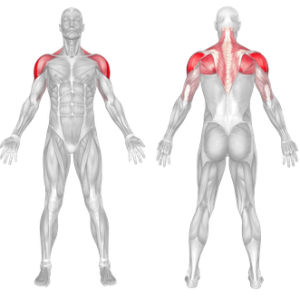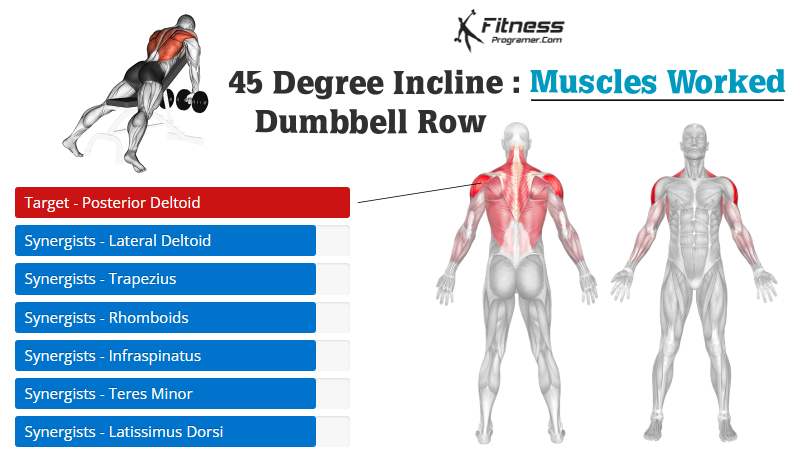Overview
The 45-degree incline dumbbell row is a strength-training exercise primarily targeting the muscles of the upper and mid-back, including the rhomboids, trapezius, and rear deltoids. Performed lying face-down on an incline bench set to 45 degrees, this exercise effectively isolates and strengthens the back muscles, improving posture, muscular balance, and functional strength.
How to Perform 45 Degree Incline Dumbbell Row
Starting Position: Adjust an incline bench to a 45-degree angle. Lie face down on the bench with your chest firmly pressed against it. Hold dumbbells with arms extended directly below shoulders, palms facing inward.
Alignment and Grip: Keep your neck neutral, spine aligned, and core slightly engaged to stabilize your body.
Pulling Movement: Pull the dumbbells upward, bending your elbows and retracting your shoulder blades, lifting until elbows align with your torso or slightly higher.
Controlled Lowering: Slowly lower the dumbbells back to the initial position, fully extending your arms without releasing shoulder tension.
Repeat: Complete 8–12 controlled repetitions per set, focusing on smooth, deliberate movements.
Tips for Proper Form :
Engage your shoulder blades by squeezing them together at the top of the movement.
Avoid excessive momentum or swinging; lift weights with controlled movement.
Maintain a neutral neck and spine position throughout.
Use manageable weight to ensure proper technique and muscle activation.
Common Mistakes:
Lifting Too Heavy: Excessive weight leads to momentum, poor form, and reduced muscle activation.
Rounding the Shoulders: Allowing shoulders to round forward can compromise posture and reduce effectiveness.
Incomplete Range of Motion: Not fully contracting the back muscles limits potential muscle development.
Benefits of the 45 Degree Incline Dumbbell Row
Targets Mid and Upper Back Muscles: Precisely engages the rhomboids, trapezius, and rear deltoids for improved muscular development and strength.
Improves Posture and Alignment: Strengthens the upper back, reducing the likelihood of rounded shoulders and poor posture.
Minimizes Lower Back Stress: The bench support isolates the upper back, significantly reducing strain on the lumbar region.
Enhances Shoulder Stability: Strengthens the stabilizing muscles around the shoulder blades, contributing to overall shoulder health.
Balances Upper-Body Muscular Development: Complements chest exercises by ensuring balanced muscular strength across the upper body.
How to Incorporate Into Your Routine
For Beginners: Start with 2–3 sets of 10–12 reps using lighter weights, emphasizing controlled technique.
For Hypertrophy (Muscle Growth): Perform 3–4 sets of 8–12 reps, moderately heavy, with deliberate contractions and controlled tempo.
For Strength and Power: Include 4–5 sets of 6–8 reps using heavier dumbbells, allowing 2–3 minutes of rest between sets.
For Functional Training: Pair with pressing exercises (such as bench presses) in a push-pull superset format for balanced muscle development.
For Rehabilitation and Postural Improvement: Incorporate into routines 2–3 times weekly, using lighter weights and focusing on strict form and smooth execution.
Muscles Worked

Frequently Asked Questions
Can beginners perform the 45-degree incline dumbbell row safely?
Yes, beginners should start with lighter weights, focusing on maintaining strict form and controlled movements.
How frequently should I perform this exercise?
Generally, incorporate this exercise into your routine once or twice weekly for optimal muscle growth and strength.
Is the incline dumbbell row better than the standard bent-over row?
The incline version isolates the upper back more effectively and places less strain on the lower back, making it suitable for targeted upper back training.
Does this exercise improve posture?
Yes, strengthening upper-back muscles contributes significantly to improved posture and reduced risk of shoulder issues.
What are good complementary exercises to pair with incline rows?
Chest exercises like dumbbell bench presses or shoulder presses are excellent complements to achieve balanced upper-body muscular development.


